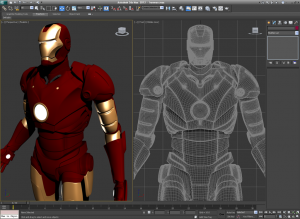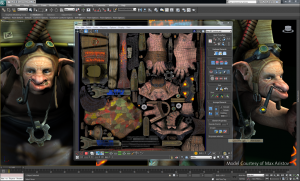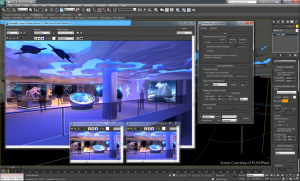By Mike de la Flor
For several releases 3ds Max users have been teased with what the Excalibur (XBR) project has in store for the future of 3ds Max. However, the full impact of XBR is clear in 3ds Max 2012 with a completely new viewport system and a new dynamics infrastructure that may rival Maya’s Nucleus.

The best new feature in 3ds Max 2012 is the Nitrous Accelerated Graphics Core which delivers blazing fast performance with massive datasets, real-time rendering effects in the viewports, and Non-photorealistic options. (Click to enlarge)
Nitrous Power
The most important update in 3ds Max 2012 is the new Nitrous Accelerated Graphics Core – a new viewport system that improves performance and display quality. As part of the XBR push to streamline and update 3ds Max 2012 Nitrous is not simply tweaks to a bloated viewport system but a complete re-engineering. Nitrous harnesses the computing power of multiple core workstations and high-end GPUs to manage and display massive datasets in the viewports faster. With Nitrous, the data in each viewport is crunched separately from all other computing processes, thus providing users with fast working environment.
To put Nitrous through its paces a heavy model composed of hundreds of parts and about two million polygons was loaded into 3ds Max 2011 and 3ds Max 2012. A mid-level Quad-core Dell workstation with an nVidia Quadro FX 4600 graphics card was used for testing. After several trials a definite pattern emerged. In 3ds Max 2011 it took at least three minutes to cached the model. Once the model was displayed the worst part was that camera rotations or mesh edits caused painfully slow redraws. In contrast, 3ds Max 2012 the model loaded almost instantly and scene changes or mesh edits (in Realistic mode with soft shadows and ambient occlusion) were smooth and in real time. The viewport performance differences between 3ds Max 2012 and 3ds Max 2011 is like night and day.
With Nitrous, effects that could only be seen after rendering can now be previewed right in the viewports. Nitrous supports effects such as ambient occlusion, high quality shadows, better transparency, and tone mapping. Nitrous provides artists with the ability to focus on the composition of a scene in real-time via immediate previews, instead of having to wait for time consuming renders. Maya 2012 features a similar viewport system dubbed Viewport 2.0. However, unlike Viewport 2.0, Nitrous does not support effects like depth of field and motion blur – maybe in the next release.
Seemingly an after thought Nitrous’ Stylized effects supposedly can display Non-photorealistic effects. However, natural media such as colored pencil, ink, and acrylics are in reality badly simulated, often having little to no similarity to the real thing. Further, there are no parameters to refine the Non-photorealistic effects.

UV mapping has gotten easier with a revamped Unwrap UVW modifier that features a reorganized UI and new tools.
Easier UV Mapping?
UV mapping is a tedious and thankless job and previous versions of 3ds Max didn’t do much to make things easier. However, 3ds Max 2012 features a revamped Unwrap UVW modifier, but does the new UI and new tools really make UV mapping less mind numbing?
The overall look and feel of the Unwrap UVW modifier (editor and command panel) has been updated and reorganized. New colorful icons are easier to see and the layout has been redesigned to accommodate regrouping of existing and new tools. For example, existing commands like Relax that were part of the menu bar have been grouped with new relax related tools and are now available in the UI. Also new tools for packing, scaling and aligning UV clusters can be found in the new rollout Arrange Elements.
Most important in the new the Unwrap UVW modifier the old Pelt mapping workflow has been replaced with Peel. The Peel rollout in the command panel features new seam creation tools of which the Point-to Point Seams is the best. Once seams are selected the Peel Mode command instantly unfolds the selection. Even better in vertex mode the new Pin tools lock selected UVs so that UV clusters can be easily reshaped in a relax-type workflow. New seams can be added on the fly with Edit Seams and unwrap changes are updated immediately while in Peel Mode. Unfortunately, it does not appear that the new seam selection tools have a mirroring option.
So is UV mapping in 3ds Max better? For 3ds Max users, yes. However, the UI is still cluttered and the workflow far too complex. In comparison, Luxology modo features a robust UV mapping (unwrapping) system that is easy to use and has far fewer tools to tinker with and can do the same job as Unwrap UVW.

In 3ds Max 2012 the Graphite Modeling tools introduce several new features including the Conform tools which make it easier to retopologize assets.
Better Graphite Modeling
Modeling in 3ds Max took a giant leap forward with the introduction of the Graphite modeling tools in 3ds Max 2010. The Graphite modeling tools provide modelers with an updated subdivision surfaces workflow and retopology tools. However, in 3ds Max 2012 the retopology workflow got better with the new Conform tools. Once a new basic mesh has been created over the mesh to be retopologized the Conform tool can “shrink wrap” the new mesh to the original. Of course this works best with a new mesh of sufficient resolution. The Conform tools also feature tools to tweak the new mesh at the sub-object level.
While the retopology tools in 3ds Max 2012 are very good, there is still room for something better. For example, 3DCoat features and awesome automatic retopology workflow that creates surprisingly accurate quad meshes with very little input from the user.
Smarter Texturing
Right up there in terms of importance with the new Nitrous viewport system is the Substance Smart Textures from Allegorithmic. Substance Smart Textures provide users with a library of 80 resolution independent, parametric texture and noise presets that can be used as is or as a starting point from which to create an almost endless array of materials.
Substance nodes output all necessary maps such as diffuse, specular, normal, bump and displacement. Each substance node features parameters to control the look of the texture. For instance, a node for a brick wall will have parameters for Age, number of bricks in the X or Y axes, depth, and so on. Substance Smart Textures can be used for most any texturing purpose, but are specifically useful in architectural visualization. Substance Smart Textures are supported in all 3ds Max renderers.
Improved Dynamics
3ds Max has consistently delivered top-notch dynamics animation, but Maya has always been just a bit better. The animation gap got even wider when Maya 8.5 introduced nCloth, the first module to the Nucleus Unified Simulation Network. Nucleus was and still is a paradigm shift in dynamics simulation. Unfortunately for 3ds Max users nothing in 3ds Max came close, however, the new MassFX Unified System (replacing Reactor) in 3ds Max 2012 promises a brighter future.
The first MassFx module of solvers is Rigid-Body. With Rigid-Body dynamics simulation is as easy as using the default gravity, assigning dynamics to an object, maybe tweaking a few parameters such as density, friction, and bounciness and watching the fast, accurate solvers do their thing in real-time. Rigid-Body also features a workflow for “modeling” such as replicating a field of boulders.

mental images’ iRay promises to free up artist from the drudgery of endless render settings by producing high-end, physically accurate, realistic imagery with less fuss.
Simpler Rendering
3ds Max ships with iRay, a new rendering engine from the makers of mental ray. iRay is high-end global illumination renderer that creates hyper-realistic photo imagery by accurately simulating the physical affects of light. The upswing of iRay is that unlike other render engines iRay creates realistic renders without having to tinker with an endless array of settings, though experience with some mental ray settings is helpful.
Also new to 3ds Max is support for vector displacement maps from Mudbox (or ZBrush). Unlike raycast (grayscale) displacements maps which can displace only along the normal, vector displacement maps can displace along all three axes. Combined with the one-click interoperability with Mudbox, a 3ds Max scene can be sent to Mudbox for high frequency sculpting, with undercuts and overhangs and then be faithfully reproduced back in 3ds Max using vector displacement.
Unfortunately, for now 3ds max does not supprt Per-face texturing (Ptex). Ptex is Disney Studio’s open source texturing method that requires no explicit UVs, instead it assigns textures (texels) to each face on the model. So far in the Autodesk stable of suites only Maya 2012 and Mudbox 2012 support Ptex, surely 3ds Max is not far behind.
If for no other reason current 3ds Max users would be wise to upgrade to 3ds Max 2012 for the new Nitrous viewport system. While not everyone will use some of the other new features like MassFx Rigid-Body or maybe iRay, everyone has to use the viewports. 3ds Max 2012 is a solid update delivering many key performance upgrades and important new tools and workflows.
Rating: Sweet
Developer: Autodesk www.autodesk.com
Platform: Windows only
Cost: $3495, Upgrade $1745

[title size="2" content_align="left" style_type="default"]Leave A Comment[/title]